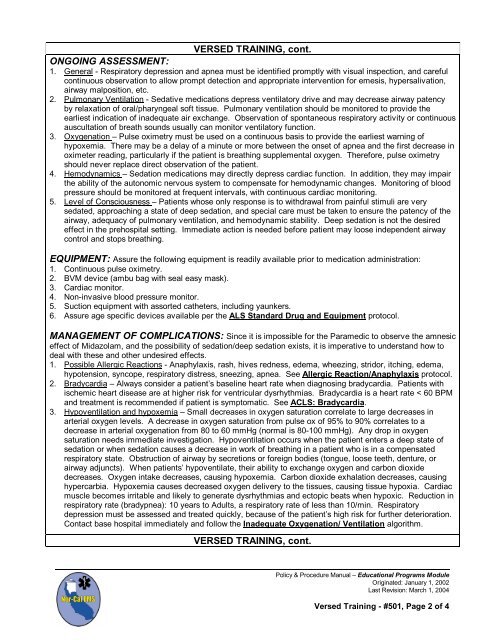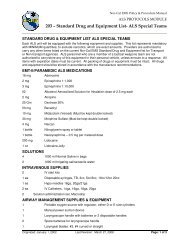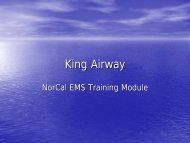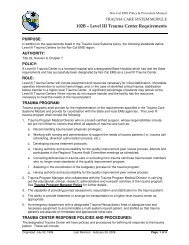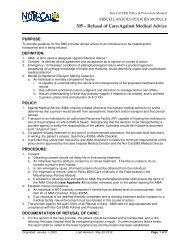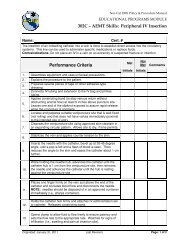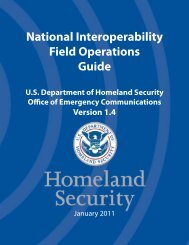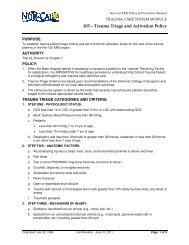Policy and Procedure Manual
Policy and Procedure Manual
Policy and Procedure Manual
Create successful ePaper yourself
Turn your PDF publications into a flip-book with our unique Google optimized e-Paper software.
VERSED TRAINING, cont.<br />
ONGOING ASSESSMENT:<br />
1. General - Respiratory depression <strong>and</strong> apnea must be identified promptly with visual inspection, <strong>and</strong> careful<br />
continuous observation to allow prompt detection <strong>and</strong> appropriate intervention for emesis, hypersalivation,<br />
airway malposition, etc.<br />
2. Pulmonary Ventilation - Sedative medications depress ventilatory drive <strong>and</strong> may decrease airway patency<br />
by relaxation of oral/pharyngeal soft tissue. Pulmonary ventilation should be monitored to provide the<br />
earliest indication of inadequate air exchange. Observation of spontaneous respiratory activity or continuous<br />
auscultation of breath sounds usually can monitor ventilatory function.<br />
3. Oxygenation – Pulse oximetry must be used on a continuous basis to provide the earliest warning of<br />
hypoxemia. There may be a delay of a minute or more between the onset of apnea <strong>and</strong> the first decrease in<br />
oximeter reading, particularly if the patient is breathing supplemental oxygen. Therefore, pulse oximetry<br />
should never replace direct observation of the patient.<br />
4. Hemodynamics – Sedation medications may directly depress cardiac function. In addition, they may impair<br />
the ability of the autonomic nervous system to compensate for hemodynamic changes. Monitoring of blood<br />
pressure should be monitored at frequent intervals, with continuous cardiac monitoring.<br />
5. Level of Consciousness – Patients whose only response is to withdrawal from painful stimuli are very<br />
sedated, approaching a state of deep sedation, <strong>and</strong> special care must be taken to ensure the patency of the<br />
airway, adequacy of pulmonary ventilation, <strong>and</strong> hemodynamic stability. Deep sedation is not the desired<br />
effect in the prehospital setting. Immediate action is needed before patient may loose independent airway<br />
control <strong>and</strong> stops breathing.<br />
EQUIPMENT: Assure the following equipment is readily available prior to medication administration:<br />
1. Continuous pulse oximetry.<br />
2. BVM device (ambu bag with seal easy mask).<br />
3. Cardiac monitor.<br />
4. Non-invasive blood pressure monitor.<br />
5. Suction equipment with assorted catheters, including yaunkers.<br />
6. Assure age specific devices available per the ALS St<strong>and</strong>ard Drug <strong>and</strong> Equipment protocol.<br />
MANAGEMENT OF COMPLICATIONS: Since it is impossible for the Paramedic to observe the amnesic<br />
effect of Midazolam, <strong>and</strong> the possibility of sedation/deep sedation exists, it is imperative to underst<strong>and</strong> how to<br />
deal with these <strong>and</strong> other undesired effects.<br />
1. Possible Allergic Reactions - Anaphylaxis, rash, hives redness, edema, wheezing, stridor, itching, edema,<br />
hypotension, syncope, respiratory distress, sneezing, apnea. See Allergic Reaction/Anaphylaxis protocol.<br />
2. Bradycardia – Always consider a patient’s baseline heart rate when diagnosing bradycardia. Patients with<br />
ischemic heart disease are at higher risk for ventricular dysrhythmias. Bradycardia is a heart rate < 60 BPM<br />
<strong>and</strong> treatment is recommended if patient is symptomatic. See ACLS: Bradycardia.<br />
3. Hypoventilation <strong>and</strong> hypoxemia – Small decreases in oxygen saturation correlate to large decreases in<br />
arterial oxygen levels. A decrease in oxygen saturation from pulse ox of 95% to 90% correlates to a<br />
decrease in arterial oxygenation from 80 to 60 mmHg (normal is 80-100 mmHg). Any drop in oxygen<br />
saturation needs immediate investigation. Hypoventilation occurs when the patient enters a deep state of<br />
sedation or when sedation causes a decrease in work of breathing in a patient who is in a compensated<br />
respiratory state. Obstruction of airway by secretions or foreign bodies (tongue, loose teeth, denture, or<br />
airway adjuncts). When patients’ hypoventilate, their ability to exchange oxygen <strong>and</strong> carbon dioxide<br />
decreases. Oxygen intake decreases, causing hypoxemia. Carbon dioxide exhalation decreases, causing<br />
hypercarbia. Hypoxemia causes decreased oxygen delivery to the tissues, causing tissue hypoxia. Cardiac<br />
muscle becomes irritable <strong>and</strong> likely to generate dysrhythmias <strong>and</strong> ectopic beats when hypoxic. Reduction in<br />
respiratory rate (bradypnea): 10 years to Adults, a respiratory rate of less than 10/min. Respiratory<br />
depression must be assessed <strong>and</strong> treated quickly, because of the patient’s high risk for further deterioration.<br />
Contact base hospital immediately <strong>and</strong> follow the Inadequate Oxygenation/ Ventilation algorithm.<br />
VERSED TRAINING, cont.<br />
<strong>Policy</strong> & <strong>Procedure</strong> <strong>Manual</strong> – Educational Programs Module<br />
Originated: January 1, 2002<br />
Last Revision: March 1, 2004<br />
Versed Training - #501, Page 2 of 4


